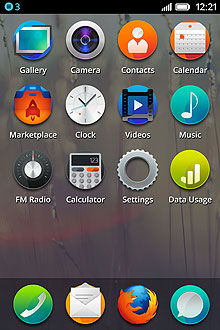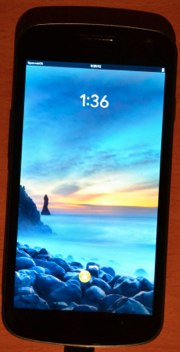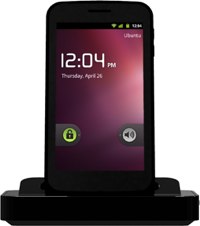Editor’s Note: This article is part two of a two-part series by Eric Brown exploring Linux-based alternatives to the Android mobile operating system. Part one ran Oct. 9: Linux Contenders Prep for a 2013 Breakout.
Yesterday, I surveyed the latest mobile open source Linux projects and examined the challenges they face against Google, Apple, Microsoft and RIM. I also explored their potential advantages, including an alignment with HTML5 and a focus on emerging markets.
Today I take a closer look at Firefox OS, Open WebOS, Jolla’s Sailfish, Tizen and Ubuntu. Most of these projects are expected to ship in new devices in 2013. Smartphones are the initial focus for most, although tablets and other devices are also on tap for some.
Firefox OS
Mozilla announced Boot to Gecko in July 2011, and in June 2012 re-launched it as Firefox OS. The operating system will run on firmware from Chinese manufacturing giants ZTE and TCL (Alcatel One Touch), and will be offered by as many as seven mobile  carriers. So far, only Spain’s Telefonica has actually promised a phone — an entry-level model due in Brazil in early 2013 under its Vivo brand. Firefox OS will then spread to similarly low-cost phones from carriers including Deutsche Telekom, Telecom Italia and Sprint, says Mozilla.
carriers. So far, only Spain’s Telefonica has actually promised a phone — an entry-level model due in Brazil in early 2013 under its Vivo brand. Firefox OS will then spread to similarly low-cost phones from carriers including Deutsche Telekom, Telecom Italia and Sprint, says Mozilla.
On Sept. 27 in China, specs were leaked of ZTE’s first Firefox OS phone, said to be due in early 2013. The phone appears to be similar to its V788D, a modest ZTE Android phone with a 3.5-inch screen and a 1.5GHz CPU.
Like Tizen, Firefox OS includes APIs that support web-based applications using HTML5, giving it a potential leg up on app development. Yet, as revealed last month when Mozilla showed off a beta version, its browser-based design goes even further, building every function with HTML5. This should make it faster and easier to develop apps than native-app platforms such as Android, claims Mozilla.
With HTML5, as well as the Gecko rendering engine’s hardware optimization of Qualcomm Snapdragon processors, Firefox OS is touted as maximizing performance on low-cost smartphones. Since Firefox OS directly exposes hardware components to HTML5, it can also skip much of the middleware required by native-app platforms. According to Mozilla, this will also help reduce handset costs, boost performance and reduce power consumption.
Firefox OS is a bold, radical design not unlike Google’s similarly web-based, laptop-targeted Chrome OS. Like Chrome OS, it could have a tough time luring users who are accustomed to native apps. But Firefox OS is not aimed so much at existing Android and iOS users as it is at consumers in underserved markets looking to buy their very first smartphone. For new users, a browser focus might make perfect sense.
Open WebOS
HP’s Open WebOS project released version 1.0 on Sept. 28, some nine months after HP announced plans for open sourcing the Linux-based WebOS platform. Last month, CEO Meg Whitman floated the idea of a smartphone coming in 2013, but backed off the comments on Oct.3, saying that an HP-branded mobile device should arrive in the next five years.
Open WebOS has been rebuilt on completely open source components, including QtWebKit, OpenAL Soft, OpenGL ES, WebGL  and Gstreamer. HP has also released some open source versions of WebOS productivity apps.
and Gstreamer. HP has also released some open source versions of WebOS productivity apps.
Version 1.0 is available as both a desktop development platform using Ubuntu and a hardware-oriented build system based on the Yocto Project’s version of OpenEmbedded. The widely used OpenEmbedded offers developers the first clear path toward building new Open WebOS devices.
OpenEmbedded is currently limited to a command line interface, but provides broad cross-compiling support, as well as an ARM emulator that can run core services. The desktop system offers the Luna System Manager as an Ubuntu app, providing basic Open WebOS productivity apps. It also supports third-party apps developed with HP’s newly open sourced Enyo 2.0 Javascript framework.
On July 31, the project disappointed users of existing WebOS devices when it confirmed that none of HP’s now defunct devices would run version 1.0. Unlike the WebOS 3.0.5 Community Edition released in June, Open WebOS 1.0 requires open source drivers supporting Linux 3.3+. It will be left up to third parties using the more limited Community version to develop such ROMs.
Fortunately, other devices are being updated to Linux 3.3, giving users some potential targets. Shortly after the version 1.0 release, the Open WebOS project announced that a related WebOS-Ports.org project had booted Open WebOS on the Samsung-built, Google-branded Galaxy Nexus Android phone. Last month, the Raspberry Pi community announced that Open WebOS had been loaded on their hacker board. There’s also a stealth-mode Phoenix International Communications project that intends to update earlier WebOS devices.
HP’s spinoff last month of its WebOS unit as a quasi-independent software development startup called Gram raises further questions surrounding HP’s plans for Open WebOS. According to HP, Gram will not design or manufacture hardware, but rather focus on “software, user experience, the cloud, engineering, and partnering.” Whatever the plan is for Gram, Open WebOS needs some more hardware, and fast. With OpenEmbedded and a stable version 1.0, at least, developers can finally get to work to make that happen.
Sailfish
MeeGo is back. Born in Feb. 2010 when Intel and Nokia merged the Atom-focused Moblin with Nokia’s ARM-oriented Maemo project, MeeGo faded quickly after Nokia pivoted to Windows Phone the next year. Shortly afterward, a Finnish startup called Jolla, comprised of former Nokia MeeGo developers, pursued its own MeeGo plans. These plans were announced in July, when Jolla CEO Jussi Hurmola was quoted as saying that two phones would ship later this year — a mass market phone and a developer model — distributed by Chinese mobile retail giant D.Phone Group.
On Oct. 2, Jolla announced that following the initial D.Phone release in China, an updated version of the OS called “Sailfish” will be “ready for licensing by other device manufacturers, design houses and service companies in spring 2013.” According to Jolla, it has raised $258 million from unstated investors and partners to support a new Sailfish Alliance and data center based in Hong Kong.
According to a ZDNet interview with Hurmola on Oct. 4, Jolla’s D.Phone models will not be part of the Sailfish Alliance, but the platforms will be much the same. Hurmola was quoted as saying that Sailfish will be highly customizable by carriers and other companies, and adaptable to tablets, TVs and other embedded platforms. More details, including a demo of the Jolla/Sailfish UI will be revealed on Nov. 21.
The date is now set for the unveiling of #Jolla user interface, enabled by the magic of open mobile Linux! #SailfishOS#Qt#merproject
— Jolla (@JollaMobile) October 4, 2012
Sailfish will be free, according to Jolla, which earlier this year said the OS would be “open source in most parts.” Sailfish uses the Qt framework, and is based on the Mer development branch, which was used on the only MeeGo phone to reach market — the Nokia N9. Mer was also the foundation for Nokia’s closed-door Meltemi mobile Linux project, which, according to Reuters, was terminated in July.
The initial Jolla phones will focus primarily on China, but Hurmola has said that Sailfish OS will also play a role in other emerging markets. One advantage it has over Firefox OS, which is targeting much the same turf, is that MeeGo/Mer was already a fairly polished smartphone platform when it shipped last year in the well-reviewed Nokia N9.
Tizen
Tizen is a spinoff from the MeeGo project, but it has adopted far less MeeGo code than Sailfish did. Hosted by The Linux Foundation and backed by former MeeGo backer Intel and leading Android vendor Samsung, Tizen was announced a little over a year ago and arrived as version 1.0 in April. An alpha version of version 2.0 was unveiled on Sept. 25.
 The Tizen 2.0 alpha arrived shortly after a Wi-Fi Alliance document surfaced that seemed to certify a Tizen version of Samsung’s Galaxy S III phone. Samsung, which released a dual-core developer phone for Tizen in limited quantities in June, is expected to announce at least one Tizen phone by early 2013, possibly by the end of the year. Tizen Association member Huawei has also said it will build a Tizen phone, and the rumor mill has hinted at possible future devices from HTC, Asus and Acer.
The Tizen 2.0 alpha arrived shortly after a Wi-Fi Alliance document surfaced that seemed to certify a Tizen version of Samsung’s Galaxy S III phone. Samsung, which released a dual-core developer phone for Tizen in limited quantities in June, is expected to announce at least one Tizen phone by early 2013, possibly by the end of the year. Tizen Association member Huawei has also said it will build a Tizen phone, and the rumor mill has hinted at possible future devices from HTC, Asus and Acer.
While Firefox OS goes all out for HTML5, letting the web technology control every function, Tizen takes a hybrid approach. It offers a native application layer, but also enables apps to be written with web technologies such as HTML5, JavaScript and CSS. Tizen offers greater support for HTML5 than any other mobile OS aside from Firefox OS.
In place of MeeGo’s Qt, Tizen 1.0 uses X11 for graphics, combined with the Enlightenment Foundation Libraries (EFL). (Qt is still part of the in-vehicle infotainment (IVI) version, however.)
The EFL libraries, as well as device APIs from the Web Application Community (WAC) standard, have been inherited from the Samsung Linux Platform, a version of the stalled LiMo (Linux Mobile) spec. Tizen is also supported by the carriers that run the LiMo Foundation, including NTT Docomo, Orange, Vodafone, SK Telecom, NEC and Panasonic. Firefox OS supporters Telefonica and Sprint have also signed on.
Residual MeeGo code appears to figure mostly in the various device-specific versions, mirroring MeeGo’s different UI layers. The initial Tizen focus is on smartphones, but work is also underway on familiar form-factors like tablets, IVI systems, smart TVs and netbooks.
So far, the early-stage smartphone UI originates largely from Samsung’s TouchWiz, as well as Samsung’s LiMo UI stack. Tizen also includes widget components from the jQuery Mobile app framework, and includes elements from Bada, which Samsung is merging into Tizen before phasing it out.
Version 2.0 adds more HTML5 features including video subtitles and captions and APIs for battery status and screen orientation. A multi-process web runtime based on Webkit2 was added for improved security and reliability.
Samsung’s involvement alone makes Tizen the de facto leader among the Linux mobile OS contenders. Considering how well Samsung continues to do with Android phones, despite the Apple lawsuit, it remains to be seen how hard it will push Tizen. If its already shaky relations with Google over Android updates deteriorate much further, however, it may be ready to take the gamble with a full line-up of Tizen devices.
(For a look inside Tizen 1.0, see Linux.com’s previous report from Nathan Willis.)
Ubuntu
For years, Ubuntu has been showing up as an alternative OS installation on x86-based tablets and mobile Internet devices (MIDs) via Ubuntu Mobile and Embedded (UME). Ubuntu was the first Linux distro to support ARM processors, resulting in Sharp’s ARM-based Netwalker PC-T1 tablet in 2010.
 None of these products did much in the market, however, and Ubuntu has never shipped with a high-profile tablet. In 2011, Ubuntu 11.04 arrived with its touch-enabled Unity interface, and in October that year Canonical founder Mark Shuttleworth announced that the Ubuntu 14.04 LTS release due in spring 2014 would “power tablets, phones, and smart screens from the car to the office kitchen.”
None of these products did much in the market, however, and Ubuntu has never shipped with a high-profile tablet. In 2011, Ubuntu 11.04 arrived with its touch-enabled Unity interface, and in October that year Canonical founder Mark Shuttleworth announced that the Ubuntu 14.04 LTS release due in spring 2014 would “power tablets, phones, and smart screens from the car to the office kitchen.”
Like Jolla, Canonical appears to be especially interested in China. In April, a Canonical rep in China said that Chinese vendors were ready to ramp up Ubuntu tablet production in 2013. In June, an Ubuntu 12.04 firmware option was made available by China tablet vendor Smart Devices for its Android 4.0-based SmartQ T20 tablet.
Canonical may be thinking of the future tablet market as it experiments with web-based apps in Ubuntu 12.10. One of its first such apps, however, is a highly controversial app that returns Amazon-driven search results.
On the smartphone front, Canonical is trying a different tack. In February, it announced a hybrid, OEM-focused Ubuntu for Android platform, and said the first phones could be announced by year’s end. On multicore phones, Ubuntu for Android enables Android and Ubuntu to share access to the Linux kernel. When on the move, Android is in charge, but when the phone plugs into a monitor-attached docking station, an Ubuntu desktop pops up.
Unlike the similar, Firefox-based Webtop technology, which Google quietly killed last week, Ubuntu for Android would offer a full gamut of desktop apps and would also provide desktop access to selected Android functions such as telephony. It’s not exactly an Ubuntu smartphone, but it’s a start.


